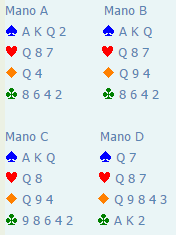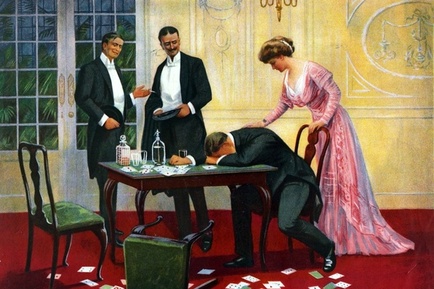Source: Mr Bridge
When you have a weak hand and your partner opens 1NT there is a danger that a 1NT contract fails, possibly quite badly. When the partnership has few high cards, the extra control afforded by having a trump suit can be vital. Furthermore, when one hand is weak, playing with a trump suit has another benefit. A ruffing entry to the weak hand may enable declarer to take a finesse or reach a winner, a chance that would not exist in 1NT. No longer does the 1NT opener struggle by having to keep leading out of the same hand. Clearly, a 4-4 fit will nearly always score better because you have trump control and will gain tricks by ruffing in either hand. However, you will often gain by playing in a 4-3 fit too.
While you cannot make an extra trick on quite a few deals, in which case clearly you would prefer not to be a level higher, quite often you can make an extra trick. If trumps break 3-3 or you manage a ruff in the short trump hand, even a 4-3 fit can be more productive than no-trumps. Traditionally, you will have heard that you should only use Stayman with 11+ points —but then it seemed sensible to include some weak options: hands that could easily deal with any response:
1) 4-4 or Longer in the Majors and Weak
![]() J 8 7 6
J 8 7 6 ![]() Q 9 8 7
Q 9 8 7 ![]() 4
4 ![]() K 5 4 3
K 5 4 3
2) Shortage in Clubs and Weak
![]() J 8 7 6
J 8 7 6 ![]() Q 9 7 6
Q 9 7 6 ![]() K 8 7 6
K 8 7 6 ![]() 4
4
With hands of type 1, you can bid Stayman and then rebid 2 of the longer major if partner replies 2![]() . With hands of type 2, you simply pass any rebid by opener. Extensive research supports my belief that we can take things a step further:
. With hands of type 2, you simply pass any rebid by opener. Extensive research supports my belief that we can take things a step further:
It is correct to use Stayman with two 4-card majors whatever your strength
Either you will find a 4-4 fit or you will find a 4-3 fit; computer simulations suggest the resulting suit contract will play better than 1NT most of the time. To play this method requires only a slight change to your methods: When you have two long majors (4+ cards in each) and a weak hand then bid Stayman. If opener replies in a major, you are happy because you have a fit and can pass. If the reply is 2![]() : Now you rebid in your longer major, if you have one, while with equal length you must bid 2
: Now you rebid in your longer major, if you have one, while with equal length you must bid 2![]() . Over 2
. Over 2![]() , when responder shows longer spades, opener passes as usual.
, when responder shows longer spades, opener passes as usual.
The key difference is the progression over a rebid of 2![]() :
:
Opener passes with 3 cards in hearts or converts to 2![]() with only 2 hearts. This ensures there will be at least a 7-card fit.
with only 2 hearts. This ensures there will be at least a 7-card fit.
This idea allows the partnership to escape on many hands and find any 4-4 major fit that is available. The hand below shows a prime example where the system gains:

In this example, if North plays in 1NT, he should make only 4 tricks (3 undertricks) because the defenders can run both minors. If he plays in 2![]() , he should make 9 tricks (1 overtrick). Clearly, things are much easier when you find a 4-4 fit. Let us also see how things would progress otherwise:
, he should make 9 tricks (1 overtrick). Clearly, things are much easier when you find a 4-4 fit. Let us also see how things would progress otherwise:
![]() 8 6 5 4
8 6 5 4 ![]() A K 3 2
A K 3 2 ![]() 7 6 5
7 6 5 ![]() 10 5
10 5
This is the responding hand from the above diagram: you should bid 2![]() Stayman to check on the opener’s shape. Here are four examples of hands for opener:
Stayman to check on the opener’s shape. Here are four examples of hands for opener:

With Hand A, opener should rebid 2![]() , and you can pass knowing that there is at least an 8-card fit. The opener should reply 2
, and you can pass knowing that there is at least an 8-card fit. The opener should reply 2![]() to your 2
to your 2![]() on the other three hands, after which you call 2
on the other three hands, after which you call 2![]() . This is not a weak take-out, rather it asks opener to choose hearts or spades.
. This is not a weak take-out, rather it asks opener to choose hearts or spades.
With Hand B, the opener should pass. He has equal length in the majors and he should disregard the fact that his spades are stronger. He knows there is at least a 7-card fit. He also knows that if you had 5 spades and 4 hearts you would have rebid 2![]() rather than 2
rather than 2![]() .
.
With Hand C, the opener should convert to 2![]() ; with Hand D, he should pass. In each case there will be at least a 7-card fit at the two level.
; with Hand D, he should pass. In each case there will be at least a 7-card fit at the two level.
After the sequence 1NT-2![]() -2
-2![]() -2
-2![]() , opener will pass whenever he holds 3 hearts. Therefore, if opener has 3 hearts facing responder’s 5 hearts and 4 spades, they will get to the same contract on the recommended method as they would if the 2
, opener will pass whenever he holds 3 hearts. Therefore, if opener has 3 hearts facing responder’s 5 hearts and 4 spades, they will get to the same contract on the recommended method as they would if the 2![]() rebid forced opener to pass. If the opener has only 2 hearts, he will have 3 spades. He will then convert to 2
rebid forced opener to pass. If the opener has only 2 hearts, he will have 3 spades. He will then convert to 2![]() . This puts them in a 7-card fit if responder is 4-5 or 4-4 in the majors and in an 8-card fit if responder is 5-5. Again, you never end up with fewer trumps than if opener had to pass 2V, as some methods require and you might end up with more. As suggested in the introduction, Acol usually treats the sequence 1NT-2
. This puts them in a 7-card fit if responder is 4-5 or 4-4 in the majors and in an 8-card fit if responder is 5-5. Again, you never end up with fewer trumps than if opener had to pass 2V, as some methods require and you might end up with more. As suggested in the introduction, Acol usually treats the sequence 1NT-2![]() -2
-2![]() -2
-2![]() , as a weak take-out (i.e. obliging opener to pass) showing at least 5 hearts and 4 spades.
, as a weak take-out (i.e. obliging opener to pass) showing at least 5 hearts and 4 spades.
This prevents the possibility of catering for situations when responder has 4 cards in each major. It is also inefficient if responder has 5 cards in each major because it means you may play in 2![]() on a 5-2 fit when a 5-3 fit is available in spades. In the new system this sequence asks opener to `pass or correct’ so that he always has three cards in the final trump contract. Computer simulations show that, with the above responding hand, 1NT makes about 34% of the time but two of a major 43% of the time. This confirms that playing in a suit is quite often worth an extra trick. However, one important proviso is that the play of the contracts can be difficult, and the defence too!
on a 5-2 fit when a 5-3 fit is available in spades. In the new system this sequence asks opener to `pass or correct’ so that he always has three cards in the final trump contract. Computer simulations show that, with the above responding hand, 1NT makes about 34% of the time but two of a major 43% of the time. This confirms that playing in a suit is quite often worth an extra trick. However, one important proviso is that the play of the contracts can be difficult, and the defence too!
Conclusion
This system does not suggest wholesale changes — it is adding only one tiny chink to the Stayman convention. You can use Stayman in the normal way with 11+ points. It just adds to the number of weak hands on which you can use it — 0-10 points and 4-4 in the majors — as well as the usual hands with 9+ cards in the majors or short clubs. The only change you need to make to your system is when the Stayman bidder rebids 211; 1NT-24-2+-211. In this sequence it is important for the opening bidder to bid 24 if his spades are longer than his hearts (otherwise he passes). It is a minor change to have to make, for what appears to give major gains. I would suggest having a go and seeing how you get on!
Esta entrada también está disponible en: Spanish

